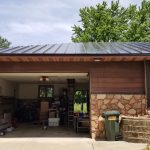By Simone du Boise for Metal Architecture Magazine
Unobtrusive, reliable, economically viable and high-performance technology is key to acceptance. Utilizing truly thin, MiaSolé photovoltaics [about as thick as a credit card] are integrated into architectural details provide an elegant and virtually invisible solution. As part of the architectural design and construction documentation, the Cadmus Building Integrated System [BIS] surpasses conventional crystalline roof-mounted or ballasted systems in a combination of production, durability and ROI. The thin-film panels are laminated to the metal roof as substrate, therefore the entire assembly (underlying roof included) qualifies for the Federal Tax Credit of 30 percent for material, labor and professional fees.
Cadmus Construction LLC, Roswell, Ga., is committed to zero energy buildings. As developers, licensed architects, certified general contractors, LEED APs and consultants, we specialize in the integration of alternative renewable energy and passive solar design. We have been using thin-film photovoltaics since 2005 and have watched the technology continue to improve. Thin films have been the only photovoltaic solution that could be seamlessly integrated into our designs and meet our performance standards. We have identified Santa Clara, Calif.-based MiaSolé Hi-Tech Corp.’s Copper Indium Gallium Diselenide [CIGS] thin film as the current leader in efficiency, performance, power loss mitigation, a variety of panel sizes, technical support, availability and reliable shipment.
Our projects are primarily USGBC LEED Platinum applicants. Therefore, we are concerned with energy and environmental design, low maintenance, long-lasting solutions, and all the critical details and specs such as Energy star roofs with appropriate irradiance levels, which, for example, directly impact the heat island effect. Typically, our solutions deploy Energy Star, industrial-grade standing seam metal roofs with thin-film solar photovoltaic panels laminated to the pans.
For example, Cadmus was contracted to provide consulting services for an integrated alternative energy system to the contractor, Resort Custom Homes, Greenville, S.C., by the architect for the project, Tom Markalunas, Markalunas Architecture Group LLC, Greenville. This custom home is located on the coast of South Carolina, so the wind uplift was of great concern and within a planned neighborhood development that has a very strict Architectural Review Board (ARB). Due to aesthetic concerns, solar panels had never previously been approved by the ARB. However, having introduced the Mia Solé panel, BIS, and performance data, the ARB reconsidered and requested a sample of the roof with laminated panels be constructed on-site for a field demonstration. There was concern about the color, weathering and accumulation of pollen on the panels. We allowed the sample to remain in place for eight weeks and the concerns were negated.
Part of our prescriptive method and process for all projects, includes an on-site solar shading analysis and an energy consumption model for the building. Cadmus designed and engineered a comprehensive and appropriately sized system that included all components based on estimated demand and projected energy production. The client was so impressed with the look and performance characteristics, they requested expansion of the system to serve a heated pool and include backup battery storage. Consequently, the size the system almost doubled to 12 kW DC. The system includes two solar thermal systems that sit below the standing seam metal roof to provide approximately 80 percent of the domestic hot water and an auxiliary system that uses excess hot water to heat the pool. A DC-coupled backup battery system shaves excess production during the day and then provides that back to the house at night. The battery system also provides emergency backup to two sub-panels in case of outages. The integrated solar thermal system wicks the heat away from the PV panels, thus increasing their output while transferring the excess heat into another energy source: hot water.
Cadmus provided on-site training to the various crews to install the alternative integrated system. The MiaSolé panels were integral to the success of the project because they provided an attractive ROI and allowed the integration of the photovoltaic technology without compromising the aesthetics.
Residential, commercial, industrial, multifamily and mixed-use projects can all benefit from this prescriptive and synergistic, solar-powered solution.





